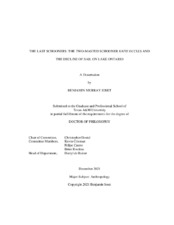| dc.description.abstract | The last quarter of the 19th century witnessed the increasing industrialization of the Great Lakes region and the emergence of the modern Great Lakes transportation system, a system which would ultimately supplant the sailing commerce which defined freight transport on the lakes throughout most of the 19th century. While steamboats were introduced to the Great Lakes as early as 1817, competition between sail and steam was limited before the middle of the 19th century, with sail and steam occupying separate economic roles in the emerging regional economy. The introduction of novel steam-propulsion technologies and more efficient steamship designs intended for carrying freights from the 1840s and 1850s brought sail and steam into direct competition.
By the early 1880s, the momentum within shipping on the Great Lakes had decidedly begun to shift toward steamships as increasingly efficient steamships and means of handling bulk freights lowered freight rates and shifted shipping markets towards bulk low-cost, low profit per ton transport, all of which favored steam. By the 1880s, Lake Ontario’s sailing fleets had been largely relegated from the profitable inter-lake trade to local trading confined within Lake Ontario and the Upper St. Lawrence and by 1900 had become almost entirely reliant on the transport of a single commodity, anthracite coal. In this local role, sailing vessels persisted for another 30 years.
In 2019 the author directed the Last Schooner Project, photogrammetrically documenting and surveying the wreck of the two-masted schooner Katie Eccles which was among the last schooners in operation on Lake Ontario. This survey produced significant information regarding the changes that sailing vessels underwent in their final years, as well as the specialized role such vessels possessed in Lake Ontario’s intra-lake trade in which sailing commerce on the Great Lakes spent its final years. | |


